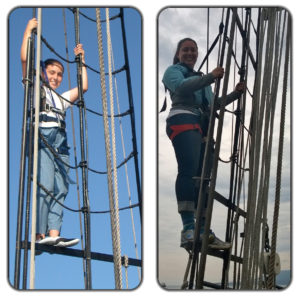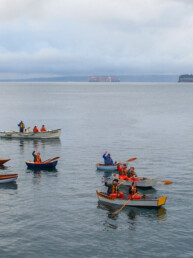This article was originally published in the March 2022 issue of 48° North.
After the Salish 100 fleet of small boats pulled ashore at Blake Island last summer, I overheard an animated conversation about a sailing program that puts girls front and center: learning about the environment and themselves while sailing a classic schooner. I soon discovered the program was called ‘Girls at the Helm’ and takes place on the well-known and much-loved schooner Adventuress. But what really piqued my interest was the enthusiasm of the speaker, Jenny Huntley.

I caught up with Huntley to learn more about her background and the program. A Washington native, Huntley grew up attending family gatherings at her grandfather’s house on Port Susan, where said members, including several carpenters, built a fleet of rowboats and some sailboats, instilling in Huntley a lifelong appreciation for small boats. “I didn’t realize until later how ingrained boats were in my life,” she said, recalling her aunt’s confidence hauling in crab traps alone and her grandmother’s delight in rowing during a storm. Sapphire, the boat she sailed in the Salish 100, was built by her father.
Huntley first stepped aboard Adventuress at age 12 as part of a four-day program with the Girl Scouts. She got to climb the rigging and steer the ship, an experience she remembers as an “absolute blast,” except for a chilly night-time anchor watch, during which she struggled to stay awake. “But the sunrise made it all worth it.”
Years later, Huntley returned to Adventuress for two seasons as shipboard program coordinator and eventually earned the role of Assistant Director of Programs and Development at Sound Experience, which uses Adventuress as a platform to run a variety of educational programs.
 Unlike some younger people who come on the scene as tall ship groupies, Huntley’s first love was marine science, especially orcas. In high school, she enjoyed her volunteer teaching gig at the Seattle Aquarium so much that a degree in biology seemed like the natural next step toward a career in marine science. But the nitty gritty of biology, combined with being a self-described “horrible test taker,” inspired a shift to environmental studies, a field which suited her better. After a capstone project developing curriculum and teaching a weeklong class for students on Sucia Island, she realized, “I could do this as a job.” Not many of us are lucky to find this vision so early.
Unlike some younger people who come on the scene as tall ship groupies, Huntley’s first love was marine science, especially orcas. In high school, she enjoyed her volunteer teaching gig at the Seattle Aquarium so much that a degree in biology seemed like the natural next step toward a career in marine science. But the nitty gritty of biology, combined with being a self-described “horrible test taker,” inspired a shift to environmental studies, a field which suited her better. After a capstone project developing curriculum and teaching a weeklong class for students on Sucia Island, she realized, “I could do this as a job.” Not many of us are lucky to find this vision so early.
Adventuress, which draws 12 feet, is 133 feet long, and weighs 98 tons, is a long way from a small boat, but Huntley sees parallels. “We use [both types of craft] as a way to explore, rather than for the technicalities. We’d rather toodle around in a cove than get from point A to B. It’s one of your tools in a tool belt.” Both types of boats also have the ability to transform a person, and in the case of the Girls at the Helm program, “to give them confidence to pursue what they want to do.”
In a normal year, the program takes a group of about 20 teenage girls aboard Adventuress for a weeklong cruise filled with science, maritime history, and teamwork. During the pandemic it ran as a scaled-back day program, but still had the same goals. In addition to learning how to run the ship, participants are guided by female mentors and experts in a variety of fields. The girls get to interact with filmmakers, scientists, and professional mariners. “They get to see women in every role on the ship without thinking about it.” Huntley notes that in addition to “Adventuress magic, there’s an emphasis aboard on supportive learning, community building, and working together on a common goal,” something we could all benefit from.

With the confidence gained from the voyage, the girls themselves often go on to do amazing things, ranging from marine research to teaching in foreign countries. Like herself, many return to enjoy the ship again. The positivity also impacts the crew, who “get validated and find it insightful to see the buzz, the discussions.”
My favorite part of our conversation was Huntley’s excitement as she described passing Tacoma with the Salish 100 fleet, sailing in 12 inches of water with myriad sand dollars visible on the bottom. Many people might have overlooked such a detail, but Huntley’s observant nature contributes to her success as a program coordinator. During our conversation she marveled that her career choice has worked out so well. “At Sound Experience, I can have a bunch of my favorite things: the Salish Sea, sailing, and teaching—all in one place.”
Bruce Bateau
Bruce Bateau sails and rows traditional boats with a modern twist in Portland, Ore. His stories and adventures can be found at www.terrapintales.wordpress.com






